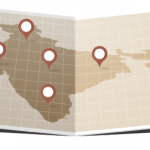Lanes are theoretic constructs—aspirations really—because a bus and truck will often drive side by side, going in the same direction on a two-lane road, trying to pass each other, pushing whoever or whatever is slower to a shoulder of brown gravel. A sign from the government says helpfully, “Lane Driving Is Safe Driving,” but I never saw anything that approached bidirectional travel.
To me, driving in India is a cross between the game of Chicken and Russian Roulette, with drivers executing maneuvers quite like the high-speed flybys in the movie Top Gun.
As I learned watching TV in India, cricket is a major interest, if not fixation there, and the batsmen have great skill. A spinning, twisting, gyrating ball, bouncing off slick grass could baffle even the best athlete in the world—someone with 20/10 vision and great reflexes with instantaneous responses—but somehow batsmen hit it.
I do not think that even the top batsman during the Ashes (i.e., a test cricket series played between England and Australia) faces as many truly difficult split-second decisions as the average driver in India, but the stakes on the road are high.
Amir was a whiz at this type of traffic, navigating the lunky Toyota with great finesse. Interestingly, although Amir has skills worthy of a Formula One driver, he uses a bicycle at home. He is saving up for a motor bike.
As a long-time investigator, however, I know a problem worthy of research when I see one, when it is time to think big & when it is time to think outside the box—or at least make the box bigger. Traffic injuries are such a problem.
Even as a passenger—cowering in the back seat, often covering my eyes—I found that driving is thrilling in its own way. The color of India is striking, always vibrant, with women even in the most menial jobs dressed magnificently. I saw a woman polishing a guard rail on the highway, but she looked ready for a party. The Tata and Ashok Leyland Trucks are decorated with elaborately painted pictures of gods and goddesses, flowers, luxuriant gardens in bright yellow and orange and neon green. From the rear view mirror of the trucks, streamers of plastic flowers bob and dance in the rushing wind.
Everywhere there is the noise of honking horns, with every pass, lane change and evasive maneuver accompanied by a beep, blare or blast. Some of the truck horns are quite melodic, as if the drivers could choose a tone or song like those available on a cell phone. I honk my horn in Durham every few years, but the average driver in India probably honks hundreds, if not thousands, of times a day, whether on a brief trip to the market or cross-country journey. Honking is not an annoyance or disturbance from a frustrated or angry driver. It is an essential act of safety to provide a semblance of order to an otherwise mad and frenzied place. Most trucks have a sign painted in ornate green or red letters that says, “Horn please.”
